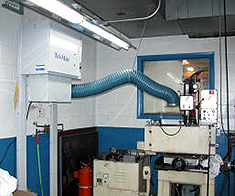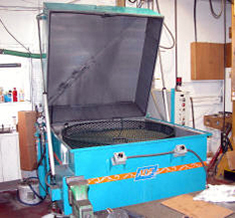Case Studies

The Problem: Voluminous amounts of mist being generated from a shell milling operation on a lathe using water-soluble coolant was flooding the work area.
The Solution: A Tri-Mist 1000 was installed on the roof of the Haas VF5 using the Tri-Mist 3” riser base. The final air filtration stage was provided using a Tri-Mist high efficiency high capacity post filter. The final result was vastly cleaner air in the work area. Upon opening the doors to the machine tool cabinet, the breathing zone is clear.

The Application: Capture coolant oil mist from two grinders.
The Solution: A Tri-Mist 850 Mist and Smoke Collector was ceiling mounted on a frame with two eight-inch flex ducts attached to the two ports on the inlet plenum. The opposite ends of the ducts were mounted to pick up ducts which were fixed to the active area of the two grinders completing a very clean source capture installation. Now the oil mist is filtered through a double pass electrostatic precipitator based mist collector and the clean air is returned to the work environment resulting in a healthier work environment.

The Application: Capture smoke being generated from an EDM operation.
The Solution: A TriMist 500 Smoke & Mist Collector mounted on an adjustable floor stand with a section of flex duct mounted from the collector to the EDM machine. Now all smoke from the operation is captured by the TriMist. The TriMist is a double pass system with two esp cells and two power supplies. The entire system runs off of a standard 115 VAC power supply.

The Application: Clean steel molds used in an aluminum casting facility.
The Solution: Aan ADF Model 800 High Pressure Spray Washer with a 52″ diameter turntable. The washer sprays heated alkaline cleaning solution at 700 psi to clean the molds which are on the turntable. The turntable rotates at 6 rpm during the cleaning cycle. The cleaning solution is filtered through a dual filtration system and is returned to the reservoir for reuse. The operator loads the parts and pushes the palm buttons to initiate the cleaning cycle. The molds are cleaned and blown dry with an automatic heated blow-off. At the end of the cleaning cycle, the cover automatically opens triggering an end of cycle signal. The molds are clean, dry and ready for the tool room or reuse in the foundry.
